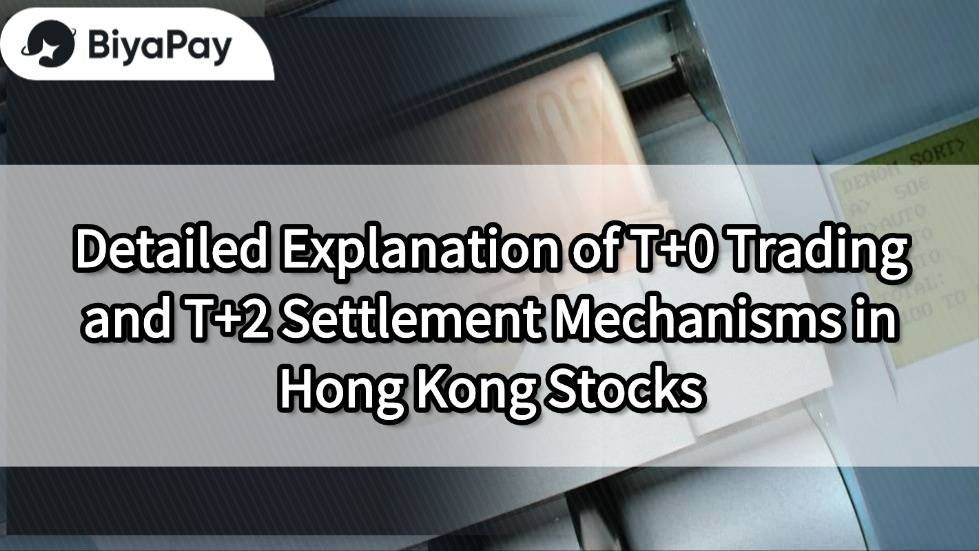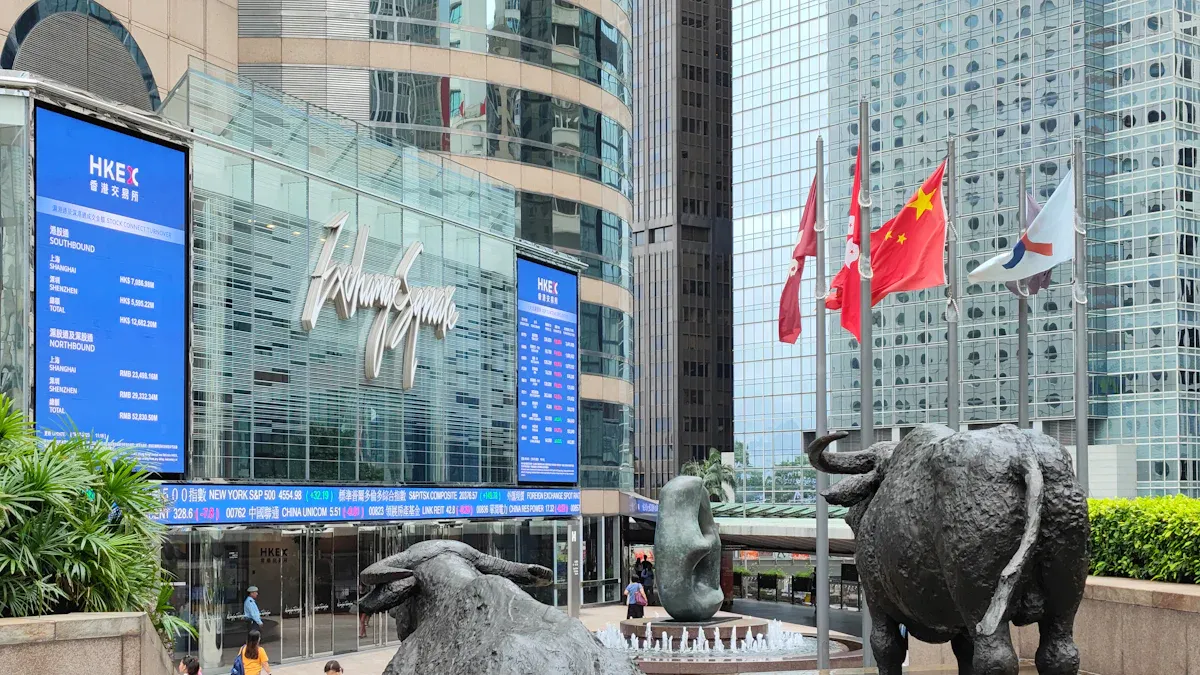- EasyCard
- Trade
- Help
- Announcement
- Academy
- SWIFT Code
- Iban Number
- Referral
- Customer Service
- Blog
- Creator
Detailed Explanation of T+0 Trading and T+2 Settlement Mechanisms in Hong Kong Stocks

Image Source: pexels
In the Hong Kong stock market, T+0 and T+2 settlement mechanisms are two core trading models. The T+0 trading mechanism allows you to buy and sell the same stock multiple times within the same trading day, greatly enhancing capital efficiency and market liquidity. In contrast, the T+2 settlement mechanism means that the formal clearing and settlement of funds and stocks occur on the second business day after the transaction is completed.
The operation of these two mechanisms is crucial to investors’ trading strategies and fund management. T+0 provides flexibility for rapid turnover, while T+2 ensures market stability and transparency. Whether you are a short-term trader or a long-term holder, understanding how these mechanisms affect your trading decisions, especially when it comes to pre-market and after-hours trading rules, is essential.
Key Points
- T+0 trading allows multiple buy and sell transactions of stocks within the same day, improving capital efficiency.
- The T+2 settlement mechanism ensures transaction security, with funds and stocks settled on the second business day.
- Short-term investors should leverage T+0 flexibility to respond quickly to market fluctuations, while long-term investors should focus on fundamental analysis.
- Proper fund management and risk control are key to successfully utilizing T+0 and T+2, avoiding settlement issues due to insufficient funds.
- Pre-market and after-hours trading provide additional operational opportunities but have lower liquidity, requiring cautious trading strategies.
T+0 Trading Mechanism Explained

Image Source: unsplash
Definition of T+0 Trading
The T+0 trading mechanism means you can buy and sell the same stock multiple times within the same trading day without waiting for settlement to complete. This mechanism is widely used in the Hong Kong stock market, forming a stark contrast to the T+1 trading system in China’s A-share market. T+0 trading allows you to sell stocks immediately after buying them on the same day, and you still retain the related rights to the securities until the T+2 settlement is completed.
For example, if you buy a Hong Kong stock in the morning, you can sell it in the afternoon without waiting for settlement to complete. This flexibility provides more operational space for short-term traders.
How T+0 Trading Works
In the Hong Kong stock market, the operation of T+0 trading is very straightforward. After you buy stocks within a trading day, the system instantly records your transaction data and allows you to sell the same stocks again on the same day. However, the actual settlement of funds and stocks follows the T+2 settlement mechanism. This means that stocks traded today will be cleared and settled on the second business day.
- Core Features:
- Stocks bought on the same day can be sold on the same day.
- The formal settlement time for funds and stocks is T+2.
- During the trading process, you still retain all rights to the stocks.
This operational model combines trading flexibility with settlement stability, meeting the needs of short-term investors while ensuring market transparency.
Advantages and Challenges of T+0 Trading
The T+0 trading mechanism offers investors various advantages but also comes with certain challenges. Understanding these characteristics helps you better formulate trading strategies.
Advantages
- High Capital Efficiency: You can conduct multiple buy and sell transactions within the same day, quickly turning over funds and increasing profit potential.
- Strong Flexibility: T+0 trading allows you to adjust holdings quickly based on market changes, responding to short-term fluctuations.
- Enhanced Market Liquidity: Higher trading frequency promotes market activity, providing investors with more trading opportunities.
Challenges
- Increased Trading Risks: Frequent trading may lead to higher transaction costs and potential losses, especially in highly volatile markets.
- Greater Psychological Pressure: Short-term operations require quick decision-making, which can create psychological stress for investors.
- Requires Advanced Expertise: T+0 trading demands a sharper judgment of market trends and strong risk management skills.
Tip: If you are a novice investor, it’s advisable to familiarize yourself with market rules and gradually try T+0 trading to avoid unnecessary risks from excessive trading.
In summary, the T+0 trading mechanism provides flexible operational space but also requires higher market sensitivity and risk control abilities. Properly utilizing this mechanism can help you achieve better investment returns in the Hong Kong stock market.
T+2 Settlement Mechanism Explained

Image Source: pexels
Definition of T+2 Settlement
The T+2 settlement mechanism is a standard clearing and settlement arrangement in the Hong Kong stock market. It refers to the formal settlement of funds and stocks completed on the second business day after a transaction. This means that when you buy or sell stocks on the trading day (T day), the related funds and stock transfers will be finalized on T+2.
For example, if you trade on a Monday, settlement will be completed on Wednesday (assuming no public holidays). This arrangement provides market participants with sufficient time to process funds and stock clearing.
The T+2 settlement mechanism is designed to balance trading efficiency and market stability. It not only ensures transaction security but also reduces risks during the clearing process.
T+2 Settlement Process
The T+2 settlement process involves multiple steps, with clear procedures from trade execution to final settlement. Below is the main operational flow:
- Trade Execution: When you buy or sell stocks on the trading day (T day), the exchange records the transaction data instantly.
- Clearing Preparation: On T+1, the exchange’s clearing system verifies the trade data to ensure the buy and sell transactions match correctly.
- Settlement Completion: On T+2, the buyer pays the funds, and the seller delivers the stocks, completing the transaction officially.
Tip: Before settlement is complete, your funds or stocks will be temporarily frozen and unavailable for other trades. Therefore, proper fund flow planning is crucial.
Below is a simplified flowchart to help you understand more intuitively:
| Time | Operation Stage | Description |
|---|---|---|
| T Day | Trade Execution | Buyer and seller complete the trade, recording data. |
| T+1 Day | Clearing Preparation | Verify trade data, prepare for settlement. |
| T+2 Day | Settlement | Funds and stocks are formally transferred. |
This process ensures transparency and accuracy in trading while reducing risks for market participants.
T+2 Settlement Time Calculation Example
Understanding how to calculate T+2 settlement time is critical for your trading plans. Below is a specific example to help you master this concept:
Suppose you buy a Hong Kong stock on October 2, 2023 (Monday), and there are no public holidays that week. According to the T+2 settlement mechanism, the settlement time is calculated as follows:
- T Day (Trading Day): October 2, 2023 (Monday).
- T+1 Day: October 3, 2023 (Tuesday), for clearing preparation.
- T+2 Day: October 4, 2023 (Wednesday), for settlement of funds and stocks.
Note: If T+2 falls on a public holiday, the settlement date will be postponed to the next business day. For example, if October 4 is a holiday, settlement would be delayed to October 5.
Here’s a more complex scenario involving a holiday:
| Trading Day | T+1 Day | T+2 Day (Settlement) |
|---|---|---|
| December 22, 2023 (Friday) | December 26, 2023 (Tuesday) | December 27, 2023 (Wednesday) |
In this example, December 25 is a Christmas holiday, so the settlement date is postponed.
Tip: Before trading, check the Hong Kong Stock Exchange’s holiday schedule to avoid settlement delays due to holidays.
In summary, the T+2 settlement mechanism provides a stable clearing and settlement framework for the Hong Kong stock market. Mastering its definition, process, and time calculation methods will help you manage trading funds and risks more effectively.
Relationship and Significance of T+0 and T+2
Complementarity of T+0 and T+2
T+0 and T+2 mechanisms complement each other in the Hong Kong stock market, each serving distinct functions. T+0 trading offers flexibility, allowing you to buy and sell stocks multiple times within the same day, quickly responding to market fluctuations. T+2 settlement ensures transaction security and stability, providing sufficient time for clearing funds and stocks.
For example, when you use T+0 for short-term trading, the T+2 settlement mechanism operates in the background to complete clearing stably, avoiding risks from overly rapid fund flows. This complementarity keeps the market active while maintaining order.
The combination of these mechanisms meets the needs of short-term investors while providing a stable trading environment for long-term investors.
Impact of T+0 and T+2 on Investment Strategies
The T+0 and T+2 mechanisms directly influence your investment strategies. T+0 trading is suitable for short-term investors, helping you seize intraday fluctuation opportunities. You can quickly build positions after the market opens and close them before the close, achieving efficient capital use.
On the other hand, T+2 settlement is more suitable for long-term investors. It provides a stable settlement framework, allowing you to focus on fundamental analysis of stocks without worrying about short-term fund flow issues.
Tip: If you prefer short-term trading, closely monitor market trends and execute trading plans quickly. For long-term investors, focus on stock selection and asset allocation.
Balancing Risks of T+0 Trading and T+2 Settlement
Balancing the risks of T+0 trading and T+2 settlement is crucial in the Hong Kong stock market. You need to flexibly utilize these mechanisms based on your investment goals and risk tolerance.
- Fund Management: Ensure sufficient funds are available for T+0 trading to meet T+2 settlement requirements. Avoid settlement issues due to insufficient funds.
- Risk Control: Set stop-loss points to prevent significant losses from short-term trading errors.
- Strategy Integration: Combine T+0 trading with T+2 settlement. For example, use T+0 trading to capture short-term opportunities while reserving some funds for long-term investments.
Reminder: When engaging in T+0 trading, avoid excessive trading to prevent increased transaction costs and psychological pressure.
Through proper fund allocation and risk management, you can more effectively utilize T+0 and T+2 mechanisms in the Hong Kong stock market, achieving stable investment returns.
Pre-Market and After-Hours Trading Rules for Hong Kong Stocks
Pre-Market Trading Rules and Features
Pre-market trading in Hong Kong stocks refers to trading activities conducted before the official trading session begins. This period is typically from 9:00 AM to 9:30 AM, divided into two phases: 9:00 AM to 9:20 AM for order input, and 9:20 AM to 9:30 AM for order matching. During this time, you can submit, modify, or cancel orders, but in the matching phase, orders are locked and cannot be altered.
The main feature of pre-market trading is smaller price fluctuations and relatively low trading volume. Due to fewer participants, market liquidity is limited, so prices may not fully reflect the true value of the stock. However, this period offers important opportunities for investors looking to enter or adjust positions early.
Tip: During pre-market trading, closely monitor market news, especially information related to company performance or policy changes, as these factors may significantly impact prices.
After-Hours Trading Rules and Features
After-hours trading in Hong Kong stocks occurs after the official trading session ends, typically from 4:00 PM to 4:10 PM. The trading method is similar to pre-market trading, divided into order input and matching phases. The main purpose of after-hours trading is to provide additional trading opportunities, especially when significant news emerges after the market closes.
After-hours trading is characterized by larger price fluctuations and potentially lower trading volumes. With even fewer participants, market liquidity may be further restricted. Therefore, prices may show significant deviations, especially under the influence of major news.
Note: When participating in after-hours trading, set reasonable price ranges to avoid unnecessary risks due to market fluctuations.
Impact of Pre-Market and After-Hours Trading on T+0 and T+2
The pre-market and after-hours trading rules in Hong Kong stocks primarily affect trading strategies and settlement arrangements. First, pre-market and after-hours trading provide more operational space for T+0 trading. You can use these periods to quickly adjust positions and capture short-term opportunities. However, due to lower liquidity during these periods, prices may be unstable, increasing the risks of short-term operations.
Second, the T+2 settlement mechanism still applies to pre-market and after-hours trading. This means that even if you complete a trade during pre-market or after-hours, the formal settlement of funds and stocks will still follow the T+2 timeline. Therefore, you need to plan fund flows carefully to ensure a smooth settlement process.
Reminder: When participating in pre-market or after-hours trading, develop flexible trading plans based on the characteristics of T+0 and T+2. Also, closely monitor market liquidity and price fluctuations to avoid losses due to operational errors.
In summary, the pre-market and after-hours trading rules in Hong Kong stocks provide investors with more trading options but also present additional challenges. Understanding these rules and their impact on T+0 and T+2 will help you manage trading risks and fund arrangements more effectively.
The T+0 and T+2 settlement mechanisms are the cornerstone of the Hong Kong stock market’s operations. T+0 offers flexibility, allowing you to respond quickly to market fluctuations; T+2 ensures transaction stability and security. These two complement each other, supporting different investment strategies.
Tip: Flexibly use T+0 to capture short-term opportunities and combine it with T+2 for long-term planning to effectively enhance investment efficiency.
Based on your investment goals, choose the appropriate mechanism and integrate risk management strategies to achieve stable returns.
FAQ
1. Is T+0 Trading Suitable for All Investors?
T+0 trading is more suitable for short-term investors, especially those skilled at capturing intraday fluctuations. If you are a beginner or prefer long-term investments, it’s advisable to familiarize yourself with market rules and try gradually to avoid increased risks from frequent trading.
2. Does the T+2 Settlement Mechanism Affect Fund Liquidity?
Yes, the T+2 settlement mechanism temporarily freezes funds or stocks until settlement is complete. You need to plan fund flows carefully to ensure sufficient funds are available for other trading needs during the settlement period.
3. What Are the Risks of Pre-Market and After-Hours Trading?
Pre-market and after-hours trading have lower liquidity, and prices may experience significant fluctuations. When participating in these periods, set reasonable price ranges and closely monitor market news to avoid unnecessary losses due to price deviations.
4. How Do T+0 and T+2 Mechanisms Affect Investment Strategies?
T+0 trading offers flexibility, suitable for short-term operations; T+2 settlement ensures transaction stability, suitable for long-term investments. You can combine the characteristics of both to flexibly adjust strategies based on market conditions, achieving efficient capital use and risk control.
5. How to Handle the Impact of Holidays During T+2 Settlement?
During the T+2 settlement period, if a public holiday occurs, the settlement date will be postponed to the next business day. It’s recommended to check the Hong Kong Stock Exchange’s holiday schedule in advance and plan trading and fund flows to avoid delays affecting your investment plans.
The T+0 and T+2 mechanisms in the Hong Kong stock market offer a perfect blend of trading flexibility and settlement stability, and efficient fund management with low-cost tools can help you seize market opportunities. BiyaPay provides a seamless financial solution, enabling trading in U.S. and Hong Kong stocks without offshore accounts, allowing you to participate in the market cost-effectively, whether leveraging T+0 to capture short-term fluctuations in pre-market or after-hours trading or combining T+2 for stable long-term investments.
It supports USD, HKD, and 30+ fiat and digital currencies with real-time exchange rate transparency, ensuring clear transactions and optimized fund arrangements during T+2 settlements. With remittance fees as low as 0.5% across 190+ countries, it facilitates flexible cross-border fund allocation to meet the needs of T+0 trading and T+2 settlements. A flexible 5.48% annualized yield savings product with no lock-in period allows idle funds to grow during trading gaps, enhancing overall returns. Sign up for BiyaPay today to combine T+0’s flexibility and T+2’s stability for an efficient, cost-saving Hong Kong stock investment journey!
*This article is provided for general information purposes and does not constitute legal, tax or other professional advice from BiyaPay or its subsidiaries and its affiliates, and it is not intended as a substitute for obtaining advice from a financial advisor or any other professional.
We make no representations, warranties or warranties, express or implied, as to the accuracy, completeness or timeliness of the contents of this publication.




Contact Us
Company and Team
BiyaPay Products
Customer Services
is a broker-dealer registered with the U.S. Securities and Exchange Commission (SEC) (No.: 802-127417), member of the Financial Industry Regulatory Authority (FINRA) (CRD: 325027), member of the Securities Investor Protection Corporation (SIPC), and regulated by FINRA and SEC.
registered with the US Financial Crimes Enforcement Network (FinCEN), as a Money Services Business (MSB), registration number: 31000218637349, and regulated by FinCEN.
registered as Financial Service Provider (FSP number: FSP1007221) in New Zealand, and is a member of the Financial Dispute Resolution Scheme, a New Zealand independent dispute resolution service provider.




















